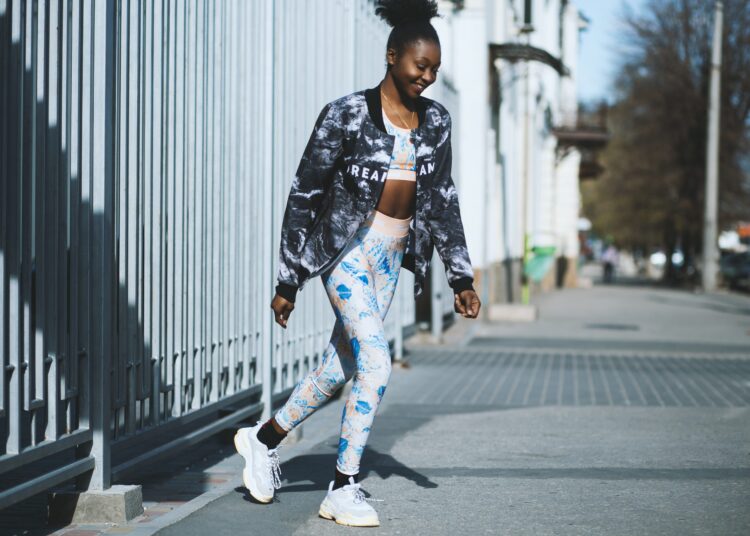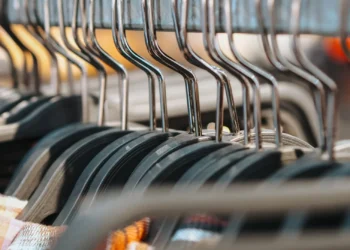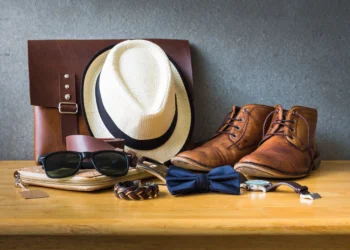Unpacking the Rise of Leggings: From Gym Gear to Everyday Essential
Dive into the story of how leggings transcended their athletic origins to become a cornerstone of modern wardrobes.
1. The Legging Revolution
Leggings have made a remarkable journey from the gym to everyday life, becoming a key element in the athleisure trend, particularly in the US and UK. Their appeal lies in the perfect blend of comfort and style, making them suitable for various activities, from workouts to casual outings.
2. Market Saturation and Shifting Trends
By the beginning of 2025, leggings accounted for a substantial 39% of the activewear bottoms assortments at major retailers.
This highlights their continued significance in the market. However, some retailers are now adjusting their inventories, suggesting a potential shift towards alternative styles like relaxed-fit joggers, indicating the dynamic nature of athleisure trends.
3. Innovation and Adaptation
Brands are evolving to meet consumer demands by offering extended sizing, sustainable fabrics, and innovative designs. This adaptation ensures leggings remain relevant and appealing to a diverse customer base, emphasizing both performance and fashion-forward aesthetics.
Sneakers That Speak Volumes: The Role of Footwear in Athleisure
Dive into how sneakers are not just footwear but a statement in the booming athleisure trend, blending performance with everyday style.
1. The Rise of Footwear in Athleisure
While clothing maintains a strong lead in the athleisure market, footwear is rapidly gaining traction, becoming the segment with the most dynamic growth. This surge is largely due to continuous technological advancements, including state-of-the-art cushioning systems and the incorporation of sustainable materials, which enhance both performance and appeal.
2. Innovation Driving Growth
Brands are strategically boosting their investments in footwear research and development. This commitment aims to leverage the expanding market opportunities and meet the evolving demands of consumers who seek both functionality and fashion in their athletic-inspired shoes.
3. “From Gym to Street”: A Style Revolution
The “From Gym to Street” trend is reshaping how we view and wear athletic gear. This movement prioritizes comfort and versatility, pushing athleisure designs towards enhanced performance capabilities, elevated style, and greater personalization—especially noticeable in footwear designs.
4. Competitive Landscape
New players entering the athleisure market are intensifying competition by introducing differentiated products and innovative designs. This influx of creativity challenges established giants and offers consumers a wider array of choices that blend athletic functionality with everyday fashion.
Hoodies & Beyond: How Sportswear Took Over Street Fashion
Explore how luxury athleisure is blurring the lines between gym wear and high fashion, reshaping wardrobes and urban style.
1. The Rise of Luxury Athleisure
Luxury athleisure is transforming fashion in the UK and US, blending athletic functionality with high-end aesthetics. Once confined to gyms, items like leggings and hoodies are now crafted from premium materials such as recycled polyamide and cashmere. This evolution caters to the demand for versatile clothing suitable for both workouts and social outings.
2. Driving Forces Behind the Trend
Several factors fuel this shift. Increased health awareness, more relaxed office dress codes due to hybrid work, and a desire for clothing that easily transitions between activities are key drivers. Major brands are innovating with advanced fabrics and designs, enhancing both performance and style.
3. Market Growth and Projections
The athleisure segment is experiencing rapid growth, outpacing other luxury apparel categories. Projections indicate a CAGR of over 5% through the decade, reflecting the increasing appeal of comfortable yet stylish urban wear. The following table illustrates part of this growth, specifically within the fitness sector:
| Segment | 2024 Participation (UK, thousands) | CAGR (Athleisure, 2025-2030) | Luxury Apparel Market Value 2025 (USD bn) | Projected Value 2030 (USD bn) |
|---|---|---|---|---|
| Fitness Classes | 6,695.5 | 5.21% | $138.64 | $172.64 |
Data Source: Sports England data cited in Mordor Intelligence “Luxury Apparel Market Size, Drivers & Opportunities, Trends 2025” Published July 4, 2025
4. The Hoodie’s Transformation
The hoodie exemplifies this trend, transitioning from sportswear to a mainstream fashion staple. It now represents a blend of comfort and confidence in urban style, seen on city streets as a symbol of this evolving fashion landscape.
Fitness Chic Demystified: Balancing Style and Functionality
Discover how the athleisure market blends performance with everyday fashion, driven by consumer demand and digital innovation.
1. Athleisure’s Impressive Growth Trajectory
The global athleisure market is experiencing significant expansion, projected to reach USD 624.75 billion by 2030. This growth is fueled by a consumer desire for versatile apparel that fits both active and casual lifestyles. The sector’s innovation lies in crafting wearables that seamlessly transition from fitness activities to everyday settings, meeting the demands of a dynamic consumer base.
2. Footwear Leading the Charge
Footwear is currently the fastest-growing segment within the athleisure market. This surge is attributed to constant innovations in cushioning technologies and the increasing use of sustainable materials. Brands are responding to consumer demands by incorporating recycled fibers and circular economy models, appealing to the environmentally conscious shopper.
3. The Rise of Online Athleisure Retail
Digital transformation is significantly impacting the athleisure market, with online retail channels expanding rapidly. These channels are growing at over 11% annually, driven by technological advancements like virtual fitting rooms and expedited delivery services. These innovations enhance personalization and convenience, catering to the modern consumer’s expectations.
4. Athleisure Market Forecast
| Year | Global Athleisure Market Value (USD Billion) | CAGR (%) 2025–2030 | Fastest-Growing Product Segment | Online Channel CAGR (%) |
|---|---|---|---|---|
| 2025 | 403.64 | 9.13 | Footwear (CAGR: 9.78%) | 11.08 |
| 2030 | 624.75 | — | — | — |
Data source: Mordor Intelligence “Athleisure Market Size, Trends, Share & Research Report 2030” July 9, 2025
The athleisure market is not just about current trends; it’s about future growth. As illustrated in the table, projections estimate a substantial increase in market value from 2025 to 2030, underscoring the sustained demand and evolving preferences in the athleisure sector.
5. Addressing Market Challenges
As the athleisure market evolves, brands face challenges such as combating counterfeit products. To address this, some are leveraging blockchain technology to ensure product authenticity. This is becoming increasingly important as the lines between athletic apparel and everyday fashion continue to blur, especially in Western markets.
The Evolution of Gym-to-Street Wearables: A New Era in Comfort and Confidence
Explore how athleisure is reshaping luxury fashion, blending performance with style for a seamless lifestyle transition.
1. The Rise of Athleisure in Luxury Apparel
The athleisure segment is not just a trend; it’s a significant force reshaping the luxury apparel market. Consumers are increasingly seeking clothing that offers both comfort and versatility, without compromising on style. This demand is propelling athleisure to the forefront of fashion, influencing how luxury brands design and market their products.
2. Outpacing Traditional Categories
What sets athleisure apart is its remarkable growth rate. With a projected annual growth rate exceeding 5% through the end of the decade, it’s outpacing other categories within the luxury apparel market. This rapid expansion underscores the increasing importance of comfortable, versatile clothing in consumers’ wardrobes.
3. Factors Driving the Athleisure Boom
Several factors contribute to the athleisure boom. Increased health awareness is a major driver, as more people prioritize active lifestyles and seek clothing that supports their fitness goals. Additionally, the shift towards more relaxed office dress codes, fueled by the rise of hybrid work environments, has further blurred the lines between gym wear and everyday attire.
4. Luxury Brands Adapt and Innovate
Luxury brands are responding to the athleisure trend by incorporating advanced textiles and performance features into their lines. This includes using materials like recycled polyamide and merino wool, known for their moisture-wicking and odor-resistant properties. The goal is to create sport-inspired designs that are suitable for both gym sessions and social settings. The table below illustrates the projected growth and market share within the luxury apparel sector, highlighting the impact of athleisure.
Q&A
Question 1: What is the primary driver behind the growth of the athleisure market, according to the provided texts?
Answer: The primary driver is the consumer demand for versatile apparel that seamlessly blends comfort and style, suitable for both workouts and everyday life. This is fueled by factors like increased health awareness, relaxed office dress codes (due to hybrid work), and a desire for clothing that easily transitions between activities.
Question 2: Which product segment within the athleisure market is experiencing the fastest growth rate, and what factors contribute to this growth?
Answer: Footwear is the fastest-growing segment. This rapid growth is driven by continuous technological advancements, such as improved cushioning systems and the incorporation of sustainable materials. Brands are also investing heavily in R&D to meet evolving consumer demands for both functionality and fashion.
Question 3: How are brands adapting to maintain the relevance and appeal of leggings in the athleisure market?
Answer: Brands are responding to evolving consumer preferences by offering extended sizing options, using sustainable fabrics, and creating innovative designs. This ensures leggings remain a desirable item for a diverse customer base, appealing to both performance-focused and fashion-conscious consumers.
Question 4: What is the projected value of the global athleisure market by 2030, and what challenges are brands facing in this expanding market?
Answer: The global athleisure market is projected to reach USD 624.75 billion by 2030. A key challenge brands face is combating counterfeit products, with some leveraging blockchain technology to ensure product authenticity and protect their brand integrity.













